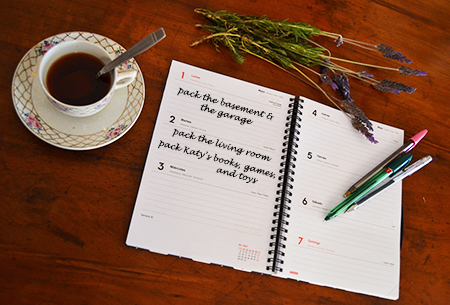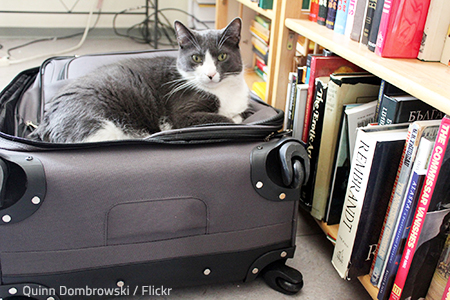Moving to a new city can give you that sense of disorientation, that uneasy feeling that you don’t really belong there. Time will often help you overcome the initial shock, but post move periods can be really tough in the very beginning, especially if you have absolutely no idea what things to do after a move.
Yet, the post relocation period doesn’t have to be tough at all. The checklist below will give you good suggestions of what to do after you move into a new house. The thing is, if you organize your time right, you won’t even have to deal with any stressful or confusing situations. Ready for some good post move checklist entries?
You know unpacking comes next, but how about learning the secrets of your new home? Sure, you’ll have to change your postal address, but have you found good health care providers yet? And yes, you should register your car after your cross country move, but isn’t making new friends your top priority?
What to do after a move? How, when, and why to do them all?
1. Organize your post move time
Welcome to your new home!
By the way, your professional movers didn’t overcharge you,
did they? Your post move period starts as soon as you step over the threshold of your new house or apartment. You’ll probably notice that the very first day after moving into a new home is mostly characterized by a feeling of relief that the house move is finally over and now you can finally shake off that nerve-wracking build-up of stress and anxiety.
Unfortunately, due to the large number of things to do when moving into a new house, you won’t have much time to get too comfortable, at least not yet. In reality, it’s very important that you organize your post relocation time the best possible way. Do you remember how much your personal moving calendar made you take advantage of every hour of every day before the residential move? Now you’ll need to do something very similar.
Yes, do consider creating a brand new to-do list that will contain all the tasks you are expected to complete now that the relocation is over. New home errands? New city tasks? Your time matters too much to just do nothing, so get down to work. Again.
2. Unpack that mountain of boxes

Besides the bedroom and bathroom, the kitchen should be the next room to unpack.
Unlike packing up your home for a move, the best thing about unpacking is that you can actually stretch it in time and complete it at a much more comfortable pace.
Unpacking after the move is important and its time consuming nature shouldn’t be underestimated, but you don’t really have a fast approaching deadline (your moving day) to try to desperately fit into.
The very first boxes you should unpack are your essentials boxes filled up with items of utmost importance. Then, you should start opening up all the Bedroom and Bathroom labeled containers, as those are the two rooms you are advised to set up with priority. After all, aren’t the thoughts in your head revolving around taking a quick shower and having a rest on your comfy bed?
Yes, unpacking is surely one of the first things to do after you move into a new home. Still, the great news here is that you’re the one controlling the unpacking speed to fit your immediate needs.
3. Learn the secrets of your new home
In most cases, your new home will be completely unknown territory for you, so it’s time to summon the explorer in you and set on an exploratory tour around the residence. Look for any signs of pre-existing damage, inspect the pipes for leaks, and keep your eyes open for unpleasant signs of infestation. Also, locate the fuse box and the main water stop valve in case of emergencies, and then write down the readings of your water- and electricity meters.
And while you’re doing that tour of yours, take mental notes of whether or not your new home is adequately secured against unauthorized access (theft), or against the destructive forces of Mother Nature. If you have a small child, then the new residence should be meticulously child-proofed as well.
Are the doors and windows as safe as they can be? Are there smoke detectors installed? What about conveniently placed fire-extinguishers on each floor? Needless to say, the fewer secrets your new place has, the better it is for you.
4. Change your postal address

Is your new home mailbox ready to receive good tidings?
Regardless of whether you moved just across town, relocated to a new city in the same state, or completed a cross country move, the postal address of your new home will be different. And that basically means that unless you take the time to change your address shortly after the house move, you’ll continue to receive your regular mail at your old address, which is no good.
Of all the things to do after you move into a new house, the task of changing your address should not be left for later. Instead, do it as soon as you can. You are given two options here: 1) you can take a walk to the local post office in person and fill out a change of address card, or 2) you can use the convenience of the global network and do it online via the
USPS website.
Oh, and don’t forget to give some cash to the new owners/renters of your old place so that they can forward your mail until that entire change of address thing takes effect.
5. Register your child at a new school
If you just moved to a new house with a school age child, then you must understand how important it is to find a new school for him or her, so that they can continue their education. That new school has to be a reputable one too so that your kid can get the best possible start of his or her life.
If you haven’t chosen a good educational institution for your son or daughter prior to the move, you have to do it now. And being one of the things to do when moving to a new city, it’s vital that you complete that important task within the set deadlines.
First, seek recommendations from friends or colleagues, or even from neighbors who happen to know which schools are good and which are not. Gathering more information online is always a plus but the best thing to do is visit a few schools together with your school age kid, speak with the principal or a few teachers there in order to get a more realistic idea about what to expect in the future.
Don’t forget to have the required documents ready to register your child at the school of your choice.
6. Find suitable health care providers

If you just moved with a small child, you’re going to have to find a good pediatrician too.
You never know how your body and mind will react to the stress of the recent move, or the conditions of the new city environment. One potential problem is that the health care provider you knew and trusted for years can no longer see you and have a look at you should you catch a cold, become more seriously ill, or simply need a specific document from a doctor.
Our moving into a new house checklist continues with another task of utmost importance – finding a new family physician for you and your family members, as well as a new veterinarian for your pet, if applicable. As was the case with the school, recommendations from people you can trust are still the best way to find the best health care provider for you.
The guiding principle should always be to keep in mind your specific medical needs, and to make the right choice between a primary care doctor and a specialized doctor. The years of experience and the type of personality of your future health care provider are also important factors to consider.
7. Register your motor vehicle
What to do after a move to a new state?
Did you have your car
transported for you? If you just crossed one or several state lines to reach your destination, then you shouldn’t forget to register your car in the new state. For your information, you may need to transfer your driver’s license as well. The good news here is that both these tasks are fairly straightforward, so all you need to do is find the time to visit the local DMV office to take care of it.
If you have no idea where that local DMV office is located, then you can use the
DMV office finder to learn of its whereabouts. However, it’s important to remember that the deadline for your motor vehicle registration in the new state may vary from around 10 days up to a full month. Therefore, either contact the
central DMV office in the state for more information, or complete this job within the next few days to avoid possible fines.
8. Help your pets acclimatize

Outdoor play is the best post relocation medicine for your dog.
If you just relocated with a pet, or pets, then you shouldn’t wonder too much about what to do after you move into a new house. This is so simply because one of the answers is too clear – you need to make sure your animal friend is feeling okay after the sudden change of scenery and unexpected leap out of their comfort zone.
The very first thing you can do for them is to clean your new place thoroughly due to the acute sense of smell of most pets, especially dogs and cats. The next best thing is to show them how much you care for them by tending to their needs, playing with them more frequently, if possible, and never leaving them alone for prolonged periods of time.
Still, the best thing you can do for your beloved pet after moving into a new home is to give them enough time to acclimatize properly to the new environment. Keep a close watch on them and consider asking for professional advice if a post relocation problem persists for more than a few weeks.
9. Make new friends
Moving into a new home can be hard for everyone involved. A possible side effect of the recent residential move is a phenomenon known as separation anxiety. The fact that you moved away from good friends and family is a reason enough to make you sad, and even depressed. And to make things worse, you probably don’t know anyone in the new city. At least not yet.
Of the various things to do after the move, your decision to make new friends is what will help you settle in quickly. Go say Hi to the folks next door in an attempt to get to know them better. Spend time with your co-workers after work and be open to new and somewhat bold opportunities to meet new people. Become a member of a new club, take dance lessons, or think about taking up a hobby that involves interaction with persons of similar interests.
But wherever the new city dynamics takes you, don’t forget to keep in touch with your old pals as that is a proven technique to
overcome relocation depression.
10. Get to know your new city

Ready for a first bumpy walk around your new city?
So, what else to do when you move to a new city?
You should get to know that new city a little better, of course! In addition to the strictly practical side of knowing where to find the most essential places in town (supermarkets, banks, medical centers, post offices, car services, schools, banks, important government institutions, etc.), the more familiar you get with the new place, the more comfortable you will feel living and working there.
Take frequent exploratory walks first in your neighborhood, and then throughout the city itself. Get familiar with the city landmarks, learn a bit more about its history, and maybe even make an effort to understand better how the locals enjoy life in general. In short, dare to step more often outside the comfort of your new home and hopefully you will soon be on friendly terms with the city you just moved to.














